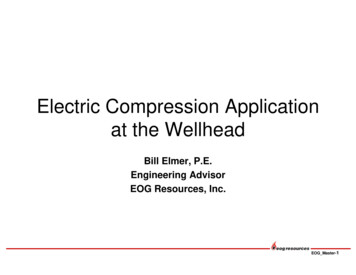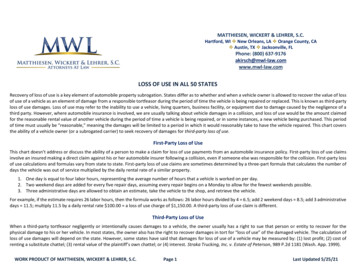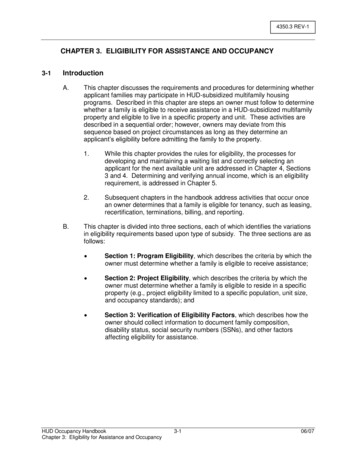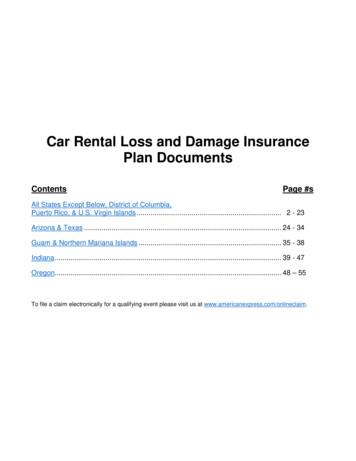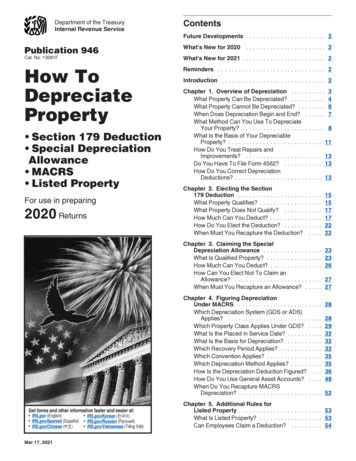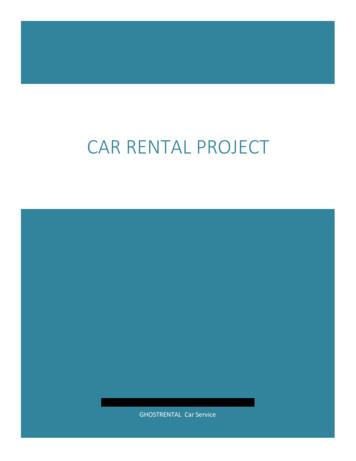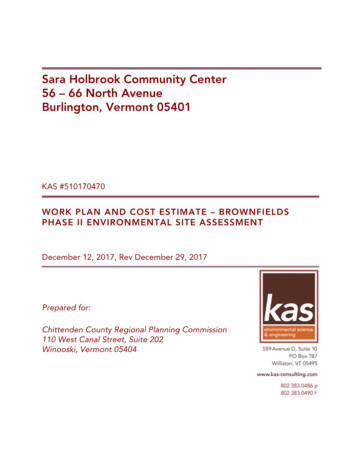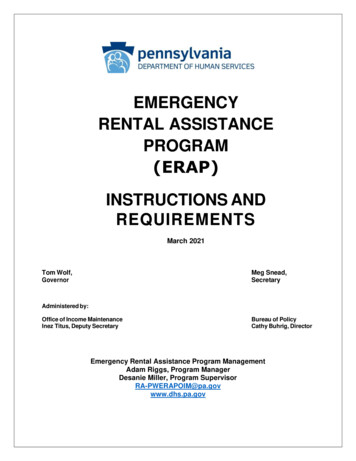
Transcription
EMERGENCYRENTAL ASSISTANCEPROGRAM(ERAP)INSTRUCTIONS ANDREQUIREMENTSMarch 2021Tom Wolf,GovernorMeg Snead,SecretaryAdministered by:Office of Income MaintenanceInez Titus, Deputy SecretaryBureau of PolicyCathy Buhrig, DirectorEmergency Rental Assistance Program ManagementAdam Riggs, Program ManagerDesanie Miller, Program SupervisorRA-PWERAPOIM@pa.govwww.dhs.pa.gov
TABLE OF CONTENTSPage1. Overview42. General Component Description53. Rental Assistance104. Housing Stability Services115. Household Eligibility126. Income Eligibility147. ERAP Expenditures178. County/ERAP Provider Responsibilities189. ERAP Fiscal Responsibilities2210. Reallocation of Funds2311. Maintaining Fiscal Records2512. County Human Services Planning and Expenditure Report2613. Client Appeals2714. Program Monitoring282
AppendicesAppendix A – Client Records30Appendix B – HIPAA Authorization Form32Appendix C – DHS Notice of Privacy Practices35Appendix D – HUD Income Inclusions and Exclusions40Appendix E – Income Calculation Worksheet44Appendix F – AMI Tables46Appendix G – ERAP Monthly Report50Appendix H – Certifications52Appendix I – Key Dates543
1. OVERVIEWA. INTRODUCTIONi.The Emergency Rental Assistance Program (ERAP) was establishedby section 501 of Division N of the Consolidated Appropriations Act,2021, Pub. L. No. 116-260 (Dec. 27, 2020). The Rental and UtilityAssistance Grant Program component of Act 1 of 2021 signed into lawby Governor Wolf on February 5, 2021, gives the Department of HumanServices (DHS) the authority to establish programmatic and eligibilityguidelines for the Emergency Rental Assistance Program.ii.ERAP is a county-administered program that offers rental assistanceand housing stability services to individuals and families experiencing orat risk for homelessness due to the novel coronavirus disease (COVID19). The ERAP Instructions & Requirements guidance will focus onthese two components:a) Rental and Utility Assistanceb) Housing Stability Servicesiii.The ERAP I & R manual provides operational guidance forimplementing the Pennsylvania ERAP including program goals,descriptions of the two ERAP components, criteria for client eligibility,allowable ERAP expenditures, fiscal reporting requirements, andexpectations for program monitoring.iv.The term “ERAP provider” refers to the county office or agencydesignated by the county to administer the ERAP program and benefitissuance, whereas, the term “county or counties” refers to the countycommissioners office or the county department receiving allocatedfunds.B. ERAP GOALSi.Counties receiving ERAP funding must develop programs to achievethe following goals:a) Mitigate the effects of homelessness on families and individualsimpacted directly or indirectly by the COVID-19 Public HealthEmergency.4
b) Provide eligible families and individuals financial assistance for rent,rental arrears, utilities and home energy costs, utility and homeenergy costs arrears, and other expenses related to housingincurred due, directly or indirectly, to COVID-19.c) At the counties option, provide housing stability services, such ascase management.d) Comply with programmatic requirements (e.g. verifying andcalculating income, maintaining case notes, etc.), reportingrequirements, and monitoring requirements as outlined in the ERAPI & R.2. GENERAL COMPONENT DESCRIPTIONSA. RENTAL AND UTILITY ASSISTANCE - Rental and utility assistance related to theCOVID-19 outbreak or unemployment includes assistance that enables eligiblehouseholds to prevent homelessness or near homelessness by aiding householdswhere housing stability is at risk. Rental, utility and other expenses related to housing,separately or when combined, can be made only for up to 12 months plus anadditional three months, if necessary, to ensure housing stability for the household,subject to the availability of funds.i.Payment for Rental Arrearsa) To provide eligible households with payment of rental arrears forup to 12-months (plus an additional three months, if necessary,to ensure housing stability for the household, subject to theavailability of funds) for past due rent that has been accrued onor after March 13, 2020.b) Rental arrears provided to an eligible household shall be madeto a landlord on behalf of the eligible household.c) If the landlord does not agree to accept such payment from theERAP provider after outreach, the provider may make suchpayments directly to the tenant for the purpose of makingpayments to the landlord.1) A payment received by a tenant must be forwarded to thelandlord to reduce the tenant's obligation.d) A landlord can apply on behalf of the tenant, and the tenantmust co-sign the application.5
e) For any payments made by an ERAP provider to a landlord, theprovider must provide documentation of such payments to theeligible household tenant.ii.Payment for Prospective Renta) An eligible household may apply for prospective rent paymentsup to three months at a time (for up to 12-months plus anadditional three months, if necessary, to ensure housing stabilityfor the household, subject to the availability of funds).1) An ERAP provider shall not provide an eligible householdwith financial assistance for prospective rent paymentsfor more than three months at a time based on anyapplication by or on behalf of the household. The totalmonths of rental assistance may not exceed 12 months(plus an additional three months, if necessary, to ensurehousing stability for the household, subject to theavailability of funds).2) Every three months, a new application and eligibilitydetermination is required for additional months requestedfor a total prospective rent payment of not more than 12months (plus an additional three months, if necessary, toensure housing stability for the household, subject to theavailability of funds).b) ERAP providers may assist households for only prospectivebenefits, however, payment to reduce rental arrears, if any,must be provided before prospective rental benefits can beprovided.c) An ERAP provider shall make future rent payments for aneligible household to a landlord on behalf of the eligiblehousehold.d) If the landlord does not agree to accept such payment from theERAP provider after outreach to the landlord by the provider,the provider may make such payments directly to the tenant ofthe eligible household for the purpose of making payments tothe landlord.1) A payment received by a tenant must be forwarded to the6
landlord to reduce the tenant's obligation.e) For any payments made by an ERAP provider to a landlord onbehalf of an eligible household, the provider must providedocumentation of such payments to the eligible householdtenant.f) An eligible household may receive prospective rent paymentsfor additional months not to exceed 12 months plus anadditional three months, if necessary, to ensure housing stabilityfor the household:1) Subject to the availability of remaining funds.2) Based on a subsequent application and eligibilitydetermination.3) Not to exceed three months of assistance allowed at onetime.a. Based on income recertification every threemonths when monthly income or attestationwithout documentation is used for incomeeligibility determination of prospective rentalassistance.g) To the extent that applicants have rental arrears, ERAPproviders may not make commitments for prospective rentpayments unless they have provided assistance to reduce aneligible household’s rental arrears.iii.Payment for Utility and Home Energy Costsa) Utilities and home energy costs are separately stated chargesrelated to the occupancy of rental property.1) Utilities include separately stated electricity, gas, water,sewer, trash removal and energy costs, such as fuel oil.2) Telecommunication services (telephone, cable, internet)delivered to the rental dwelling are not considered to beutilities.3) Utilities that are covered by the landlord within rent must7
be treated as rent and paid as rent or rental arrears.b) An eligible household may apply for payment of utility and homeenergy costs for up to 12-months (plus an additional threemonths, if necessary, to ensure housing stability for thehousehold, subject to the availability of funds).c) The ERAP provider shall make payments to a utility provider onbehalf of the eligible household.d) If the utility provider does not agree to accept an ERAP paymentafter outreach to the utility provider, the ERAP provider maymake such payments directly to the tenant of the eligiblehousehold for the purpose of making payments to the utilityprovider.1) A payment received by a tenant must be forwarded to theutility service provider to reduce the tenant’s obligation.e) For any payments made by an ERAP provider to a utilityprovider, the ERAP provider must provide documentation ofsuch payments to the tenant of the eligible household.iv.Payment for Utility and Home Energy Costs Arrearsa) An ERAP provider shall provide eligible households withpayment of utility arrears for up to 12 months for arrearages thathave been accrued on or after March 13, 2020.b) An ERAP provider shall make payments to a utility provider onbehalf of the tenant of the eligible household for utilities andhome energy costs arrears.c) If the utility provider does not agree to accept such paymentfrom the ERAP provider after outreach to the utility provider bythe ERAP provider, the ERAP provider may make suchpayments directly to the tenant of the eligible household for thepurpose of making payments to the utility provider.1) A payment received by a tenant must be forwarded tothe utility service provider to reduce the tenant’sobligation.d) For any payments made by an ERAP provider to a utility8
provider on behalf of an eligible household, the ERAPprovider must provide documentation of such payments tothe tenant of the eligible household.v.Payments for Other Expenses Related to Housinga) A provider may provide payments for other expenses related tohousing incurred due, directly or indirectly, to the COVID-19outbreak. Such assistance shall be provided for a period not toexceed 12 months for expenses accrued after March 13, 2020,except that providers may provide assistance for an additional 3months, (beyond the 12 month limitation), only if necessary toensure housing stability for a household subject to theavailability of funds.b) Other expenses related to housing include but are not limited torelocation expenses, rental fees, reasonable late fees, internetservices if needed for work or home schooling or telemedicine.c) An ERAP provider shall make payments to a provider on behalfof the tenant of the eligible household for other expensesrelated to housing.d) If the provider of the related housing expense does not agree toaccept such payment from the ERAP provider after outreach tothe provider by the ERAP provider, the ERAP provider maymake such payments directly to the tenant of the eligiblehousehold for the purpose of making payments to the housingexpense provider.1) A payment received by a tenant must be forwarded tothe utility service provider to reduce the tenant’sobligation.e) For any payments made by an ERAP provider to a housingexpense provider on behalf of an eligible household, the ERAPprovider must provide documentation of such payments to thetenant of the eligible household.B. HOUSING STABILITY SERVICES – Housing stability services related to theCOVID-19 outbreak include those that enable eligible households to maintain orobtain housing. Housing stability services are optional services and are not required9
under ERAP. Housing stability services may include:i.Housing or fair housing counseling.ii.Case management related to housing stability.iii.Housing related services for survivors of domestic abuse or humantrafficking.iv.Attorney fees related to eviction or utility termination proceedings toinclude counsel, advice, or representation for mediation and housingservices, resource navigation and income support, and other legalservices designed to help tenants remain in their home or preventhomelessness.v.Specialized service for individuals with disabilities or seniors thatsupports their ability to access or maintain housing.3. RENTAL ASSISTANCEA. ERAP Providers are required to ensure that the following procedures are in place:i.Processing applications for assistance so that the household isserved in time to resolve the crisis and prevent eviction ensures thatindividuals do not have a break in housing. Providing timelyassistance prevents additional expenditures for the household, thelandlord and the agency. It is recommended that providers, to thebest of their ability:a) Permit individuals to apply for rental assistance on the same daythey visit the office whenever possibleb) Review the application on the same day the applicant applieswhenever possible for rental assistance or within a reasonableamount of time from application.c) Provide an applicant with a pending verification list and areasonable due date for returning the pending items if allverification items are not presented with the application.d) If all required verification is presented, determine eligibility asexpeditiously as possible10
ii.Individuals or families living in subsidized housing and Section 8housing are also eligible for rental assistance.iii.Rental assistance includes rental costs for trailers and trailer lots.iv.Providers may consider hotels, motels, and boarding homes aslong-term housing and the county may or may not choose to assistclients with rental assistance payments in these situations. Clientsrequesting this type of assistance must provide writtendocumentation of long-term living arrangements. Thisdocumentation may include a receipt for a security deposit, a signedlease agreement, or other documentation that verifies the unit willbe or has been a long-term living arrangement.v.Provide the client with a written notice approving or denying theirrequest for assistance.vi.Provide the client with written details on their right to appeal adverseactions and the process to do so (see “Client Appeals” for moredetails on the appeal process).vii.Utilize collateral contacts to assist in obtaining verifications todetermine eligibility and for questionable documents.B. Counties may choose, but are not obligated, to use funds to move clients from onecounty to another county. If a county chooses to provide funding to move a client toanother county, the county should contact the receiving county agency to informthem of the services provided and the payment amount to avoid duplication ofservices.4. HOUSING STABILITY SERVICESA. Counties may use the housing stability services component to coordinate theactivities necessary for the client to maintain or obtain housing.B. Housing stability services shall not exceed 9.09 percent of the amount of the totalDHS ERAP allocation. (REMINDER: The maximum allowed administrative costs, upto 5 percent, is also deducted from the 9.09 percent.)C. DHS recommends ERAP providers leverage existing working relationships with othercommunity service providers and any agencies that can support the family inmaintaining and securing housing. By working with a local network of human serviceagencies, the ERAP provider can also become aware, as confidentiality allows, of11
the service plans within other agencies and establish goals that do not conflict. Forany referrals or exchange of identifying information, the client must sign a validwritten HIPAA compliant authorization. (See ‘Appendix B” HIPAA AuthorizationForm.)D. CASE MANAGEMENT UNDER HOUSING STABILITY SERVICESi.The following provisions under this section D are applicable whenERAP providers opt to provide case management under HousingStability Services for the client to obtain or retain housing and toachieve self-sufficiency.ii.Case management is defined as a “collaborative process thatassesses, plans, implements, coordinates, monitors, and evaluates theoptions and services required to meet the client’s health and humanservice needs. It is characterized by advocacy, communication, andresource management and promotes quality and cost-effectiveinterventions and outcomes.” For case management resources visitthe HUD Exchange.iii.Protecting the client's confidentiality in accordance with the HealthInsurance Portability and Accountability Act (HIPAA).5. HOUSEHOLD ELIGIBILITYA. Eligible Household:i.The term “eligible household” means a household of one or moreindividuals who are obligated to pay rent on a residential dwellingand with respect to which the ERAP providers involved determines a) That one or more individuals within the household has1) Qualified for unemployment benefits, or2) Experienced a reduction in household income,incurred significant costs, or experienced otherfinancial hardship due, directly or indirectly, to theCOVID–19 outbreak, which the applicant shalldemonstrate or attest in writing.b) That one or more individuals within the household candemonstrate a risk of experiencing homelessness or housing12
instability, which may include:1) a past due utility or rent notice or eviction notice.2) unsafe or unhealthy living conditions; or3) any other evidence of such risk, as determined by theERAP provider involved; andc) The household has an annual or monthly household income thatis not more than 80 percent of the Area Median Income (AMI) forthe household size.ii.Youths 17 years of age and younger, living as part of a family unit,and not emancipated, are not eligible to apply for ERAP services.iii.An individual is considered an emancipated minor and may applyfor ERAP services if he or she is 17 years of age or younger andliving as a separate family unit from their parents or is married orseparated from a spouse or is a parent caring for children.iv.Counties must respect client confidentiality, provide a Notice OfPrivacy Practices (see “Appendix C” DHS Notice of PrivacyPractices) and seek written permission for release of informationfrom the client. Counties must maintain written releases in the clientrecord.v.In reviewing applications for financial assistance, the ERAP providershall prioritize consideration of the applications of an eligiblehousehold that satisfies any of the following conditions:a) The income of the household does not exceed 50 percent of theAMI for the household ORb) One or more individuals within the household are unemployedas of the date of the application for assistance and have notbeen employed for the 90-day period preceding such date.vi.Rental assistance may not be duplicative of other federally fundedrental assistance provided to households.vii.ERAP Providers may use a signed attestation from the applicantaffirming they have not used any other federal funded assistance13
for the same expense. The county must also verify that the expenseis still outstanding.6. Income EligibilityA. This section outlines the income guidelines that ERAP providers must follow toensure consistency in determining financial eligibility across ERAP.B. ERAP providers may determine income eligibility based on either the household’stotal annual income for calendar year 2020 or the household’s monthly income at thetime of application.i.Annual Income is the total gross income of all adult householdmembers before any deductions are taken.ii.Monthly Income is the total monthly gross income of all adultmembers provided at application and extrapolated over a 12-monthperiod to determine whether household income exceeds 80 percentof the area median income.C. Providers must count the total gross income of each adult person (18 years of ageor older and not in high school full-time) when determining eligibility.D. Providers must retain copies of the income verification, the calculations used tocalculate eligibility, and amount of assistance granted in the client record.E. Income Determination:i.In determining the income of a household for eligibility purposes,the ERAP provider involved shall consider:a) The household’s total gross annual income for calendar year2020, orb) Sufficient confirmation of the household’s monthly gross income(30 days prior to the date of application), or14
c) Categorical eligibility where income has been verified with adetermination letter in connection with participation in anotherfederal, state or local government program with income limits ator below 80% AMI.ii.Using monthly income requires redetermination of eligibility of ahousehold after each period of prospective rent of three monthsbased on the subsequent application required to be filed for eachthree-month period.iii.To calculate annual gross income using monthly income informationwhen determining eligibility, the ERAP provider will follow thesesteps: (see “Appendix E” for the Income Calculation Worksheetexample).a) STEP 1: Add the gross income in the 30 days prior to the dateof application (from all sources) to arrive at a total.b) STEP 2: Divide the total by the number of weeks in the 30-dayperiod. The provider uses this weekly average as arepresentative week.c) STEP 3: Multiply the representative week by 52 to arrive at anestimated annual gross income.d) STEP 4: Clients with an estimated annual gross income at orbelow the county’s AMI limit for the household size are incomeeligible for ERAP services (see “Appendix F” AMI Tables).iv.Income used to determine eligibility follows HUD income inclusionsand exclusions requirements at 24 CFR 5.609(b) and (c). (See“Appendix D” HUD Income Inclusions and Exclusions for acomplete list.)F. Calculating Income from Self-Employment.i.When an applicant is self-employed, the profit from self-employmentcounts as gross earned income. An individual is self-employedwhen he or she owns and operates his or her own business, trade,or profession. Examples of self-employment include day careprovider, hair stylist, nail technician, mowing lawns, shoveling snow,selling cosmetic products, selling produce, and renting a room inone's home.15
ii.Use the best information available to estimate the income theapplicant expects to receive from self-employment. The ERAPprovider may base the estimate on prior earnings, if it correctlyrepresents the self-employment income, or the provider may useincome tax returns and other records.iii.To determine profit from self-employment:a) Total the prior earnings or the income from the tax returns orother records.b) Deduct any allowable costs of producing self-employmentincome.c) Divide the result by the number of months the income isexpected to cover and use that as the representative month.iv.Allowable costs of producing self-employment income are the dayto-day expenses of operating a business, but not the costs ofestablishing or improving a business. If the applicant does notprovide verification of the allowable cost, compute profit without thededuction.a) Examples of allowable costs:1) Costs of maintaining a place of business such as rent,utilities, insurance on the business and its property,and property taxes.2) Interest on the purchase of income-producingequipment and property.3) Employee labor costs.4) Cost of goods sold, supplies, and materials.5) Advertising costs.6) Accounting and legal fees.7) Professional licensing fees and union dues, ifnecessary, to practice a profession or trade; and8) Transportation costs necessary to produce income.16
7. ERAP EXPENDITURESA. Overviewi.DHS will financially participate only in expenditures that are:a) Necessary and proper for the operation of the ERAP and forproviding eligible services to eligible clients.b) Limited to the amount of the grant.ii.DHS is not responsible for funding a deficit incurred by a county orERAP provider.iii.Not more than 5 percent of the grant funds shall be utilized to coverthe costs of administering the program.B. Expenditures – Rental and Utility Assistance and Other Housing Expensesi.Allowable:a) The total combined months that a household can receiverental, utility and/or other expenses related to housing up to 12months (plus an additional three months, if necessary, to ensurehousing stability for the household, subject to the availability offunds).1) Example: If a household receives 3 months of onlyutility arrears, it can only get 9 months of prospectiverent payments (plus an additional three months, ifnecessary, to ensure housing stability for thehousehold). If getting all three types of assistance forthe same month, it would only count as one monthtoward the limitation.2) Example: Tenant was provided prospective rent forJuly and August (2 months) and then applies inSeptember for Utility arrears for August. The tenantstill only used 2 months, July and August.b) Total prospective rental payments, (including but not limited to,lot rental payments) for up to three months at a time for a totalof 12 months plus an additional three months, if necessary, to17
ensure housing stability for the household, subject to theavailability of funds.c) Total amount of rental arrearages (including lot rentalarrearages), incurred on or after March 13, 2020, for up to 12months plus an additional three months, if necessary, to ensurehousing stability for the household, subject to the availability offunds.d) Total utility arrearages incurred on or after March 13, 2020, forup to 12 months plus an additional three months, if necessary,to ensure housing stability for the household, subject to theavailability of funds. (The current utility bill is considered anarrearage if the service has been provided.)e) Other expenses related to housing incurred due, directly orindirectly, to COVID-19 for up to 12 months plus an additionalthree months, if necessary, to ensure housing stability for thehousehold, subject to the availability of funds. See Section2(A)(v).C. ADMINISTRATIVE COSTSi.Associated administrative costs may not exceed more than 5percent of the total allocated funds. Administrative costs are costsattributable to providing financial assistance and housing stabilityservices respectively, including data collection, landlord outreachand reporting requirements related to such funds.ii.Administrative costs factor into the overall percent allowed forhousing stability services.a) EXAMPLE: If only 3 percent is spent on administrative coststhen 6.09 percent may be used for housing stability services.The combined total of administrative costs and housing stabilityservices shall not exceed 9.09 percent and the totaladministrative costs shall not exceed 5 percent.8. COUNTY/ERAP PROVIDER RESPONSIBILITIESA. Generali.The county may retain primary responsibility for delivering ERAP18
services or the county may subgrant funds to nonprofit agencies todeliver services.ii.If the county subgrants the administration of the ERAP, thesubgrantee is responsible to meet all county requirements.iii.When a county subgrants ERAP services to other agencies, thecounty remains the department’s point of contact for the countyERAP services.iv.When the county ERAP administrator is unavailable, thedepartment reserves the right to contact subgrantees directly.v.Counties must provide the department ERAP Program Managerwith a list of subgrantees and contact information. In all cases, thecounty is ultimately responsible for compliance with the county andERAP provider requirements:B. County Responsibilitiesi.Administer and disburse grant funds for the provision of rental andutility assistance and housing stability services in accordance withthese guidelines, information from the department and federal andstate requirements.ii.Establish or maintain, in agreement with another county, localcollaborative arrangements for the delivery of rental and utilityassistance and housing stability services.iii.Determine and redetermine, in accordance with the informationprovided by the department, whether a household is eligible toparticipate in the program.iv.Submit monthly reports to the department, which shall includeidentified excess or insufficient funding and an itemization ofexpenditures for administrative costs. The reports shall be subjectto audit as determined by the department.v.Review, approve, and summarize all ERAP reports submitted to thecounty by service providers and submit the county summariesONLY to the department. The county must maintain the providerreports.vi.Comply with timeframes for reporting and requests outlined in19
Appendix G ERAP Monthly report and Appendix I Key Dates.vii.Ensure that participation in the ERAP is not dependent upon aclient's affiliation with, or attendance at, religious or politicalactivities.viii.Ensure that the program does not discriminate against any personbecause of race, color, religious creed, ancestry, national origin,age, sex, gender, disability, lifestyle, or sexual orientation. Anyperson who asserts that denial or termination of services is basedon discrimination because of any of these reasons must beinformed by the county of their right to appeal to the PennsylvaniaHuman Relations Commission.ix.Ensure that clients are served with ERAP funds and that funds areexpended only on allowable services as described in theseInstructions and Requirements.x.Meet applicable Fire and Panic Regulations, and applicable healthand safety requirements for all facilities where service is provided,whether rented or owned by the county or ERAP provider.C. Outreachi.ERAP providers must make reasonable efforts to obtain thecooperation of landlords and utility providers to accept paymentsfrom ERAP before determining that the landlord or utility providerwill not accept direct payment from the ERAP provider. Outreachefforts should be documented in case records for non-participatinglandlords or utility providers.ii.In general, rental and utility assistance can be provided mosteffectively and efficiently when the landlord or utility providerparticipates in the program. Outreach will be considered complete ifa) A request for participation is sent in writing, by mail, to thelandlord or utility provider, and the addressee does not respondto the request withi
4 1. OVERVIEW A. INTRODUCTION i. The Emergency Rental Assistance Program (ERAP) was established by section


